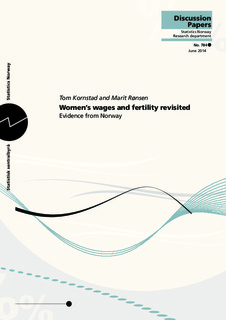| dc.contributor.author | Kornstad, Tom | |
| dc.contributor.author | Rønsen, Marit | |
| dc.coverage.spatial | Norway | nb_NO |
| dc.date.accessioned | 2019-11-11T11:58:18Z | |
| dc.date.available | 2019-11-11T11:58:18Z | |
| dc.date.issued | 2014-06 | |
| dc.identifier.issn | 1892-753X | |
| dc.identifier.uri | http://hdl.handle.net/11250/2627696 | |
| dc.description.abstract | Since the 1960s, Beckers’ New Home Economics has provided a central theoretical framework for studies of fertility behaviour. New Home Economics predict a negative effect of female wages on fertility. This prediction has been tested in a number of studies over the past decades, but the results are far from unanimous. In this paper we review past evidence of the impact of female wages on their childbearing behaviour and supply new evidence from Norway. We estimate a simultaneous hazard rate model of transitions to first, second and third birth, including predicted wage as a timedependent variable. Using a very large dataset covering all women born in Norway during the period 1955-74, we find that timing of births is associated with wage changes. The wage effect on the log hazard is U-shaped for all the four 5-year cohorts we are studying, but the effect varies across cohorts and parity. We also find that the relationship between timing of births and wages are not very sensitive to the omission of the women’s non-labour income. | nb_NO |
| dc.description.sponsorship | Norwegian Research Council | nb_NO |
| dc.language.iso | eng | nb_NO |
| dc.publisher | Statistisk sentralbyrå | nb_NO |
| dc.relation.ispartofseries | Discussion papers;784 | |
| dc.subject | JEL classification: J13 | nb_NO |
| dc.subject | JEL classification: J30 | nb_NO |
| dc.title | Women’s wages and fertility revisited. Evidence from Norway | nb_NO |
| dc.type | Working paper | nb_NO |
| dc.description.version | publishedVersion | nb_NO |
| dc.subject.nsi | VDP::Matematikk og Naturvitenskap: 400::Matematikk: 410::Statistikk: 412 | nb_NO |
| dc.source.pagenumber | 33 | nb_NO |
